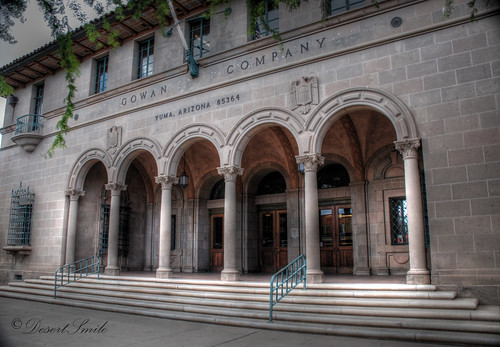When staying in the Yuma area, it is good advice to go see the old town of Yuma. Even though there are also newer buildings it still bears the flavour of bygone days,
Some single buildings seem to be from the beginning of last century.
Yuma has indeed a rich history beginning already at the time when several Indian tribes were populating the banks of the Colorado River, these were namely the Quechans, the Cocopahs and the Mohaves. Recording, however, first started in the 16th. century when explorers, adventurers and pioneers were pressing on to reach the American west. At that time the river was broad, untamed and wild rushing towards the Gulf of California. Some places the river bed was 15miles wide and quite impossible to fort. Because of a geological formation the river narrowed into a 400 yards wide channel at the future town site of Yuma. Until 1950 the tribe of the Quechans were also called the Yumas and as a result the Colorado Fort was called Yuma Crossing.
Yumas history recordings began on a day in 1540 when the Spanish explorer Hernando de Alarcon arrived at the Colorado River. From that day and until 1854 Yuma was under the Spanish and Mexican flag. Then, in 1854 and as part of the Gadsden Purchase Yuma became part of the U.S. Territory.
As a strategic point with an increasing east-west traffic Fort Yuma was founded in 1849. Being the only viable south western route 60.000 people passed through Yuma from 1849-1850. During this time the town was called Colorado City. In 1870 Yuma had become an integral part of the Wild West and represented a challenge for law and order. Bandits preyed upon the civilized part of the population and in 1876 the Arizona Territorial Prison was built in Yuma. housing the most dangerous and notorious criminals until 1909. It soon became a symbol of frontier justice and still stands as a landmark for Arizona's intolerance of treachery.

Thanks for visiting!



No comments:
Post a Comment
We like to hear from you. You can add your comment here: